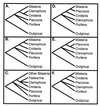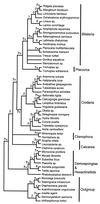Evaluating multiple alternative hypotheses for the origin of Bilateria: an analysis of 18S rRNA molecular evidence
- PMID: 9860990
- PMCID: PMC28064
- DOI: 10.1073/pnas.95.26.15458
Evaluating multiple alternative hypotheses for the origin of Bilateria: an analysis of 18S rRNA molecular evidence
Abstract
Six alternative hypotheses for the phylogenetic origin of Bilateria are evaluated by using complete 18S rRNA gene sequences for 52 taxa. These data suggest that there is little support for three of these hypotheses. Bilateria is not likely to be the sister group of Radiata or Ctenophora, nor is it likely that Bilateria gave rise to Cnidaria or Ctenophora. Instead, these data reveal a close relationship between bilaterians, placozoans, and cnidarians. From this, several inferences can be drawn. Morphological features that previously have been identified as synapomorphies of Bilateria and Ctenophora, e.g., mesoderm, more likely evolved independently in each clade. The endomesodermal muscles of bilaterians may be homologous to the endodermal muscles of cnidarians, implying that the original bilaterian mesodermal muscles were myoepithelial. Placozoans should have a gastrulation stage during development. Of the three hypotheses that cannot be falsified with the 18S rRNA data, one is most strongly supported. This hypothesis states that Bilateria and Placozoa share a more recent common ancestor than either does to Cnidaria. If true, the simplicity of placozoan body architecture is secondarily derived from a more complex ancestor. This simplification may have occurred in association with a planula-type larva becoming reproductive before metamorphosis. If this simplification took place during the common history that placozoans share with bilaterians, then placozoan genes that contain a homeobox, such as Trox2, should be explored, for they may include the gene or genes most closely related to Hox genes of bilaterians.
Figures



References
-
- Haeckel E. Systematische Phylogenie der Wirbellosen Thiere. Berlin: Reimer; 1896.
-
- Hyman L H. The Invertebrates: I. Protozoa through Ctenophora. New York: McGraw-Hill; 1940.
-
- Hyman L H. The Invertebrates: II. Platyhelminthes and Rhyncocoela, The acoelomate Bilateria. New York: McGraw-Hill; 1951.
-
- Harbison G R. In: The Origins and Relationships of Lower Invertebrates. Conway Morris S, George J D, Gibson R, Platt H M, editors. Oxford: Clarendon; 1985. pp. 78–100.
-
- Wilmer P. Invertebrate Relationships: Patterns in Animal Evolution. Cambridge, U.K.: Cambridge Univ. Press; 1990.
Publication types
MeSH terms
Substances
Associated data
- Actions
- Actions
- Actions
- Actions
- Actions
- Actions
- Actions
- Actions
- Actions
- Actions
LinkOut - more resources
Full Text Sources
Molecular Biology Databases
Research Materials

